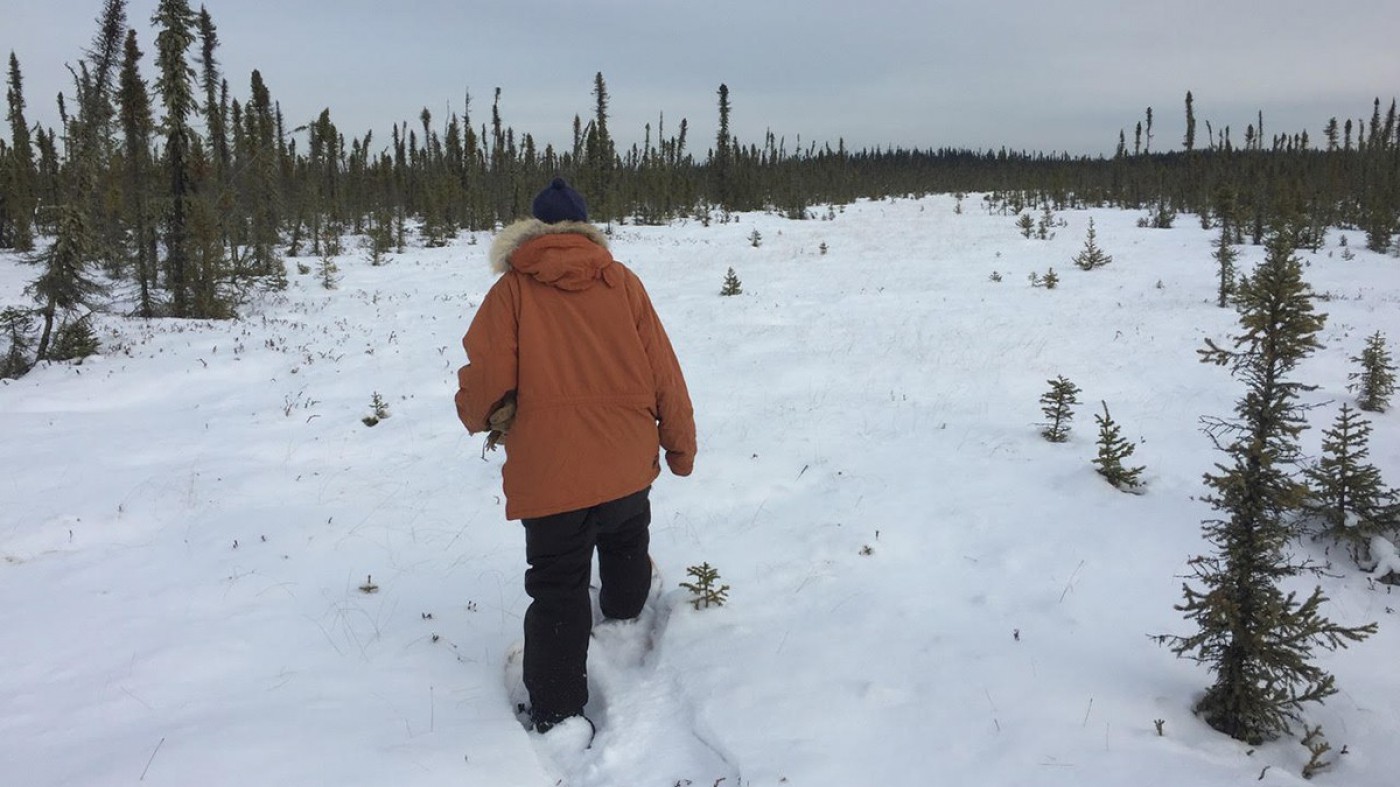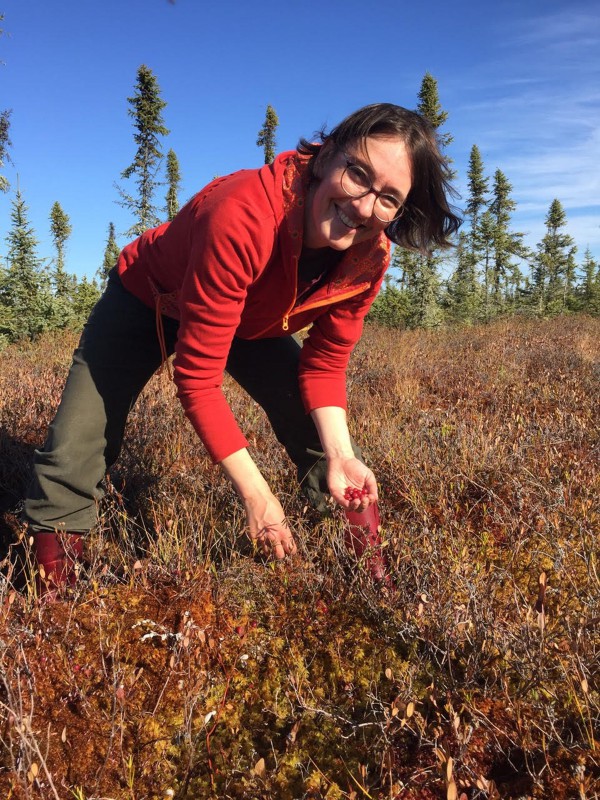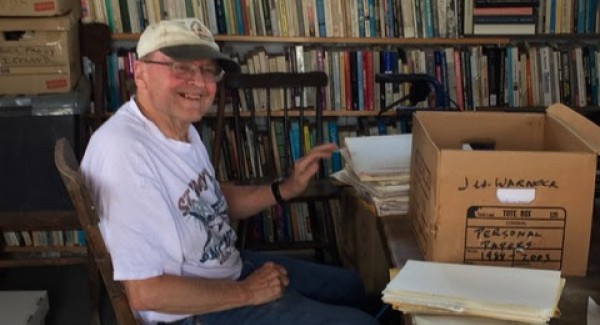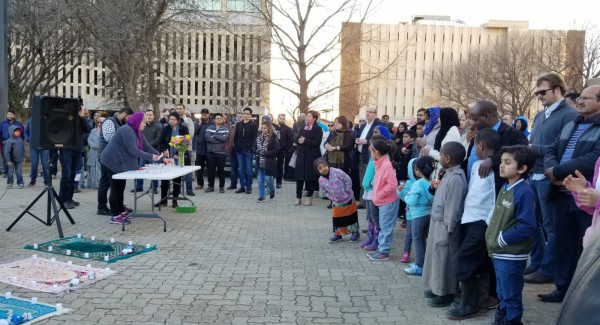Protecting the peatlands

South-east of La Ronge, a person snowshoes through wintry peatlands. These peatlands are part of Cluster 10, an area set to be mined by Lambert Peat Moss Inc. Photos courtesy of Quincy Miller
In September, Kona Barreda, a teacher in the northern community of Air Ronge, was working on a lesson about “finding the courage” for her Grade 7 class when she came across a proposal from Quebec-based company Lambert Peat Moss Inc. The company had outlined its plan, with a timeline of 80 years, to mine peat in four designated areas south of nearby La Ronge, an area covering about 2,619 hectares. Shocked by the implications, Barreda, a Woodland Cree woman, started asking people in the community if they had heard about the project. Although Lambert claimed to have distributed letters among residents, no one Barreda spoke to had received one. Hoping to teach her students how to find the courage to fight for a cause, even when the opponent is a multimillion-dollar mining company, Barreda and the Grade 7 class launched a petition demanding that Lambert leave the northern Saskatchewan muskegs alone. For the community, the fight had just begun.
Within weeks, the news of Lambert’s proposal had sent ripples of distress through the community. Contingent upon approval from the Government of Saskatchewan, the project, which is currently undergoing an environmental impact assessment (EIA), is slated to begin in 2021. In the proposal document, the company also hints at setting up a “Lambert processing and packaging facility” in the future. However, the community has been relentless in its efforts to put a stop to the project.
Hoping to teach her students how to find the courage to fight for a cause, even when the opponent is a multimillion-dollar mining company, Barreda and the Grade 7 class launched a petition demanding that Lambert leave the northern Saskatchewan muskegs alone.
Miriam Körner, a resident of Potato Lake, a community located near the project’s designated Cluster 3, was one of the few people who attended Lambert’s online community engagement meeting in September 2020, and she now manages the Facebook group “For Peat’s Sake – Protecting Northern Saskatchewan Muskegs.” After the initial meeting with Lambert, Körner convened a community meeting to deliberate the potential impacts of the project. “We decided we needed to inform ourselves and others better about the muskegs and the impact of mining,” Körner says. “Thus, ‘For Peat’s Sake’ was born. Now we have over 900 members on [Facebook].” The petition started by Barreda and her students has also seen high levels of engagement. As of December 2020, more than 19,000 people have signed it.
Miriam Körner picks berries in the peatlands south of La Ronge.
Globally, peatland mining has been identified as a source of multifarious environmental issues. Peatlands themselves are an ecosystem’s powerhouse, and destroying these wetlands can disrupt the entire ecological balance of the region far beyond the boundaries of the bog. The most important ecological role of peatlands is carbon storage. Although peatlands, also called bogs and muskegs, cover only 3 per cent of the Earth’s surface, they store twice the carbon of all the world’s forests combined. Peatlands also regulate water flows, mitigating the risk of flooding and preventing drought. In addition, they act as natural water cleansers and support a rich assortment of flora and fauna, which is why they are sometimes called “nature’s nurseries.” Because peatlands are highly acidic, and by extension an excellent medium for preserving organic matter, they also function as historical and environmental archives, enabling scientists to reconstruct regional climates and ecologies across time.
Peatland formation, however, is a process that takes time. Organic matter – comprised of plant debris, animal remains, and chemical composites – accumulates over millennia to form a thick layer of peat, ranging from 40 centimetres to many metres deep. The average accumulation rate, though it varies geographically, is usually one millimetre per year. This means that over the course of a millennium, the peatland will grow by only one metre, which hardly makes it a renewable resource. On top of it all, as these peatlands are stripped and drained for profit, all the carbon that they’ve been storing for millennia is released into the atmosphere, contributing to climate change.
Although peatlands, also called bogs and muskegs, cover only 3 per cent of the Earth’s surface, they store twice the carbon of all the world’s forests combined.
In addition to the EIA, some federal-level legislation may also apply to the proposed project, given the ecological significance of the region, its fragility, and the biodiversity dependent on it. These include the Species at Risk Act, Fisheries Act, and Migratory Birds Convention Act. Perhaps the species most at stake, if the project goes ahead, is the woodland caribou. These concave-hoofed members of the deer family rely on peatlands for lichens and water, and they are already classified as an endangered species. Alarmingly, the project area falls right within the critical habitat of the species. Given the potential for the catastrophic destruction of ecosystems and wildlife, Körner says that activists in the region are looking into ways to get the project’s effects evaluated under the federal Impact Assessment Act.
In many ways, Lambert’s proposal shows that the doctrine of discovery is alive and well in Canada. The company is treating the area as terra nullius – but the designated land parcels are not just abandoned peat estates waiting to be stripped and harvested, they are lands of social, economic, and cultural significance to the region’s Cree, and Métis communities. Eleanor Hegland and Lorie Peters-Whiteman are half-sisters and members of Lac La Ronge Indian Band, which has been active in opposing the mining project. Hegland has spent 25 years in her traditional territory and is a Traditional Knowledge Keeper and trapper. Peters-Whiteman is a social worker in private practice. Ever since news broke of a potential peat mining project in La Ronge, the sisters have been actively organizing against the project. They assert that the project violates their Treaty and Aboriginal Rights to traditional land use, which, in their words, includes “the trees, plants, and animals for traditional medicines and food sustainability, and the water system. It also infringes on our traditional ways of knowing and being on the land.” They argue that “the environmental and social impacts far outweigh the economic benefits.”
Alarmingly, the project area falls right within the critical habitat of the endangered woodland caribou.
The company estimates that the project will create 25 seasonal jobs for locals. However, in exchange for 25 jobs, the community stands to lose a lot more. The targeted clusters are commonly used for fishing, trapping, and hunting. Hegland and Peters-Whiteman are worried that berry picking and trapping will be severely impacted, while Körner is concerned about the elevated risks of flooding and increased forest fires. Körner’s fear of fire is not unfounded; there has been considerable evidence of fires erupting following peatlands’ drainage and harvesting. In 2015, Indonesia experienced one of the country’s worst forest fires, which spread acrid smoke across borders to Malaysia, Thailand, and Singapore. These fires were traced back to the peat soil lying beneath forests that were burned to clear way for new farmland. This should hardly come as a surprise, since peat is a highly combustible material, and when exposed to dry conditions (particularly following drainage) is susceptible to catching fire. Elsewhere in Canada, peat mining has led to the eutrophication of surrounding bodies of water, like Manitoba’s Lake Winnipeg, where an excess of nutrients in the water led to algae blooms that disrupted the lake’s ecosystem.
The process of peat stripping is carbon intensive and leads to a host of environmental challenges. The initial phase of peat mining involves the construction of access roads, drainage networks, and site clearing, including removing the entire vegetation cover to eliminate any “barriers” to project activities. The site is drained prior to harvesting to achieve the required level of moisture, which draws down the water table. Once the field has been levelled, giant harrowers are deployed to dry up the peat, which is extracted through peat vacuum harvesters latched onto powerful tractors.
Hegland has been working closely with local trappers to help them raise their concerns about the project’s potential impacts on the designated fur blocks that fall within the project’s scoping area. Lambert’s proposal mentions that the nature of the project would likely trigger the duty to consult with three First Nations and three Métis communities. However, Hegland says, ‘‘The #N-5 Fur Conservation Association (which represents approximately 120 members, located within Zones 1–5) has already voted NO against the Peat Moss Project, in Napatak and Potato Lake areas.” This should leave little room for further negotiation.
"It also infringes on our traditional ways of knowing and being on the land. ... The environmental and social impacts far outweigh the economic benefits.”
In an effort to pre-empt resistance from communities, mitigation and restoration plans have now become a common practice for companies who want to acquire regulatory and social licences for resource extraction. Lambert’s proposal mentions a “progressive restoration process” and that its “restoration goal is to return the area to a peatland.” However, it is difficult to establish whether a disturbed peatland can ever get back to its pristine state. A report published by International Institute for Sustainable Development in 2015 notes that it is not quite possible to bring a peatland to its pre-extraction state, although there are practices that can at least help restore some of the key peatland ecosystem functions. Since peat accumulation is an extremely slow process, there are no quick fixes. And even if the key functions of a peatland are restored, the loss of historical archive is permanent.
Barreda, in her bid to save the land, is now working on a virtual land-keepers conference, to which she plans to invite political figures, ecologists, professors, lawyers, and activists, and she is also reaching out to the David Suzuki Foundation and Greta Thunberg. She says, “In Indigenous cultures, we are taught to think about the repercussions of our actions seven generations into the future. Even though I will be long gone and forgotten, I hope my legacy to fight for this land will never die.” Körner feels the community’s collective efforts have looped them into something much bigger than the mining proposal itself. She concludes, “We’re part of a paradigm shift – and this shift might not happen today or tomorrow, but there is no doubt in my mind that it will – or we’ll go extinct, whichever comes first.”
Update, March 2, 2021: This article originally stated that the land to be mined is of significance to Nakota, Anishinaabeg, Dene, Cree, and Métis communities. It has been updated to reflect that there are no Nakota, Anishinaabeg, or Dene communities in the region.




